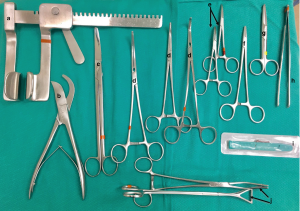There are several types of thoracotomy:
Anterolateral thoracotomy: emergency maneuver
This operation is carried out on the left side of the chest through a 6 to 8 cm incision in order to access the anterior passages of the rib cage and perform cardiac massage with the help of Thoracotomy surgical instrument set. Anterolateral thoracotomy is used in cases of heart disease following trauma to the rib cage.
Posterolateral thoracotomy: classic operation
This is done in the fifth intercostal space through an incision and a section of part of the latissimus dorsi muscle. Quite invasive operation, it nevertheless allows access to a large number of organs. It concerns pathologies of the pleura, lung, esophagus, diaphragm and part of the mediastinum (thoracic aorta, superior vena cava and trachea) and in particular pulmonary resection (lobectomy or pneumonectomy).
The midline sternotomy or sternal incision
This operation requires opening the breastbone in half vertically, freeing access to the lungs and the heart. It is performed in cases where both lungs must be affected or certain cardiac operations (coronary bypass surgery). At the end of the operation, the two parts of the sternum are reattached with metal wires.
A rib retractor is used to access the affected organs.
Thoracotomy procedure
Preparing for the thoracotomy
Depending on the pathology to be treated, several examinations may be requested before the operation:
A respiratory function test (RFE) to assess respiratory capacity
A blood gas test to measure the level of carbon dioxide and oxygen in the arterial blood
An electrocardiogram
An x-ray of the lungs
A consultation with an anesthetist
The day of the operation
Thoracotomies are mostly performed under general anesthesia. The installation of mechanical ventilation and a probe in the trachea will then be necessary.
The surgery lasts on average between 2 and 3 hours.
The patient is monitored for a few hours in the recovery room before returning to his room.
Why do a thoracotomy?
Apart from emergency measures and special cardiac operations, and given the invasiveness of this operation, caregivers do not always favor thoractomy to explore or treat the rib cage.
Anterolateral thoracotomy is indicated as an emergency to treat cardiac arrest following thoracic trauma (gunshot wound in the heart area or car accident, for example).
Posterolateral thoracotomy is indicated to treat lung diseases, in particular cancer (removal of the lungs, biopsy, etc.) Video-assisted surgery is nevertheless preferred for taking tissue samples (biopsy).
The midline sternotomy or sternal incision is used for a large number of heart operations.
After the operation
Awakening
As after any surgery, the operated area will be painful. The pain is managed with suitable medication and a morphine pump may also be prescribed.
The nursing staff will guide the patient in daily activities and will be able to give advice for a successful convalescence.
The days following the operation
At the end of the 5 to 6 days of hospitalization required, the patient can go home.
The chest drains installed at the end of the operation were removed.
The stitches can be removed.
During recovery, pain may persist for several weeks throughout the rib cage. Analgesics may be prescribed.
Due to the pain, the patient may find it difficult to breathe properly and cough, respiratory kinesis sessions are very effective in helping the patient during this stage.
After a month and if there have been no complications, the patient can gradually resume physical activity.
Complications
Like any surgical procedure, thoracotomy involves risks of complications, including:
Infections
Respiratory failure
Blood loss
A bronchopleural fistula (abnormal communication between the bronchial tree and the pleura)
An effusion of the pericardium
For more details, please visit: jimymedical.co.uk
 Bloggers Trend Keeping You Up To Date
Bloggers Trend Keeping You Up To Date

